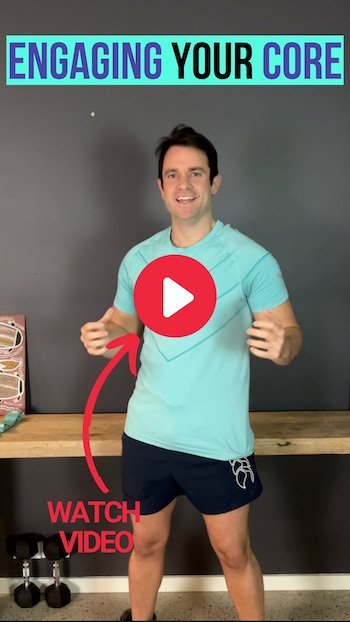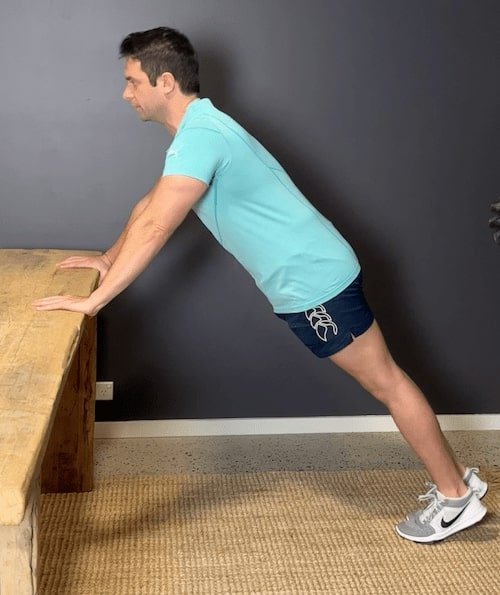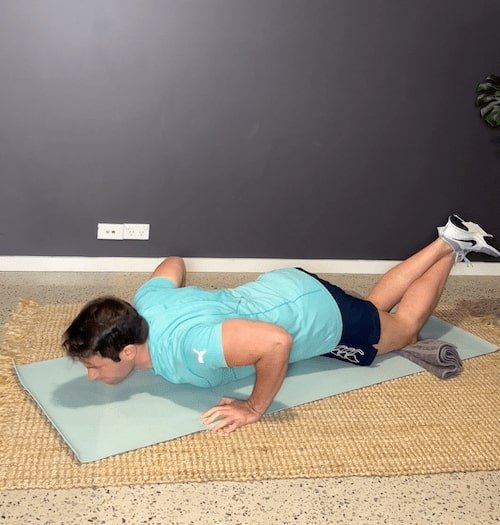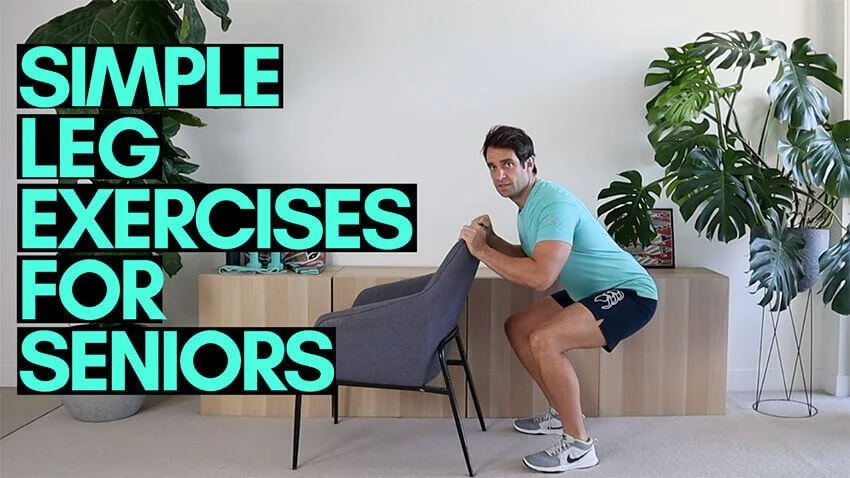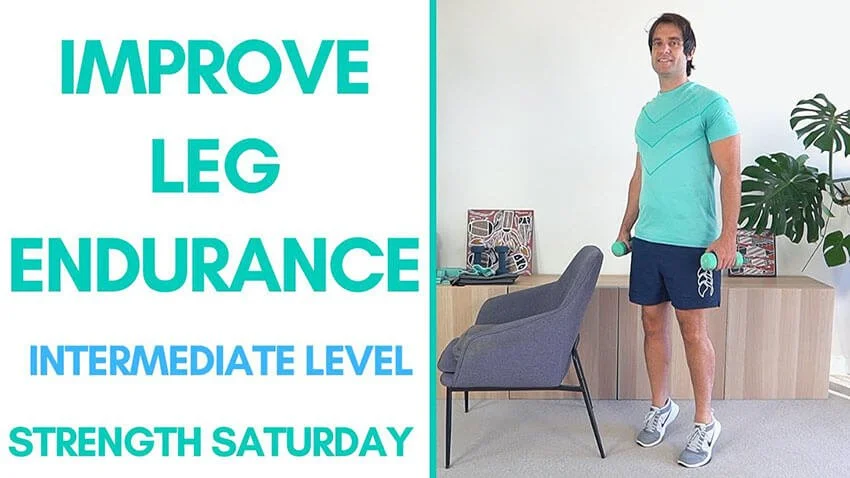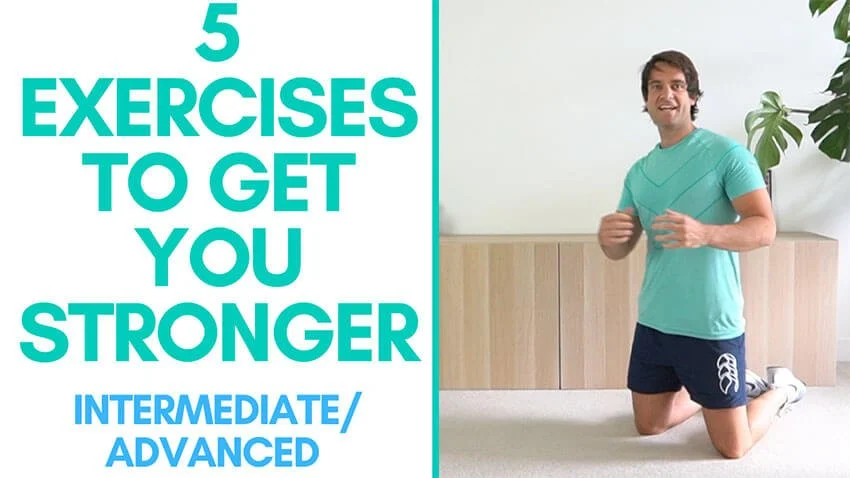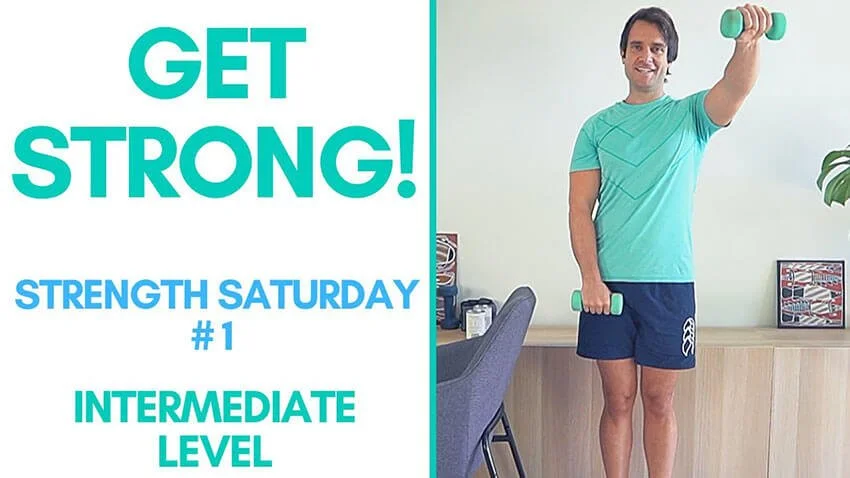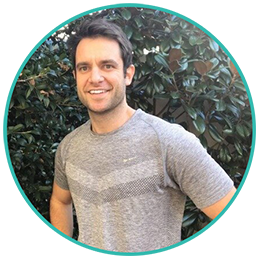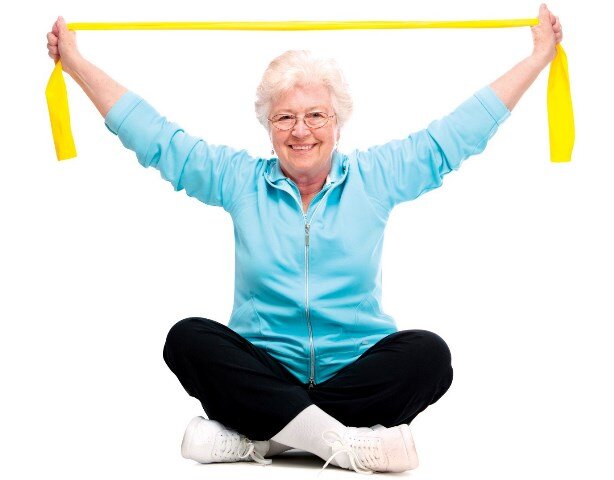
More Life Health blog. Discussing:
Seniors Exercise. Seniors Health. Seniors Fitness. Fall prevention for Seniors and more!
Glute Strengthening Exercises For Seniors
The gluteal muscles (our buttocks) are comprised of the gluteus maximus, gluteus medius, and gluteus minimus and they are the largest and strongest muscles in our body.
They're responsible for many important tasks, like walking, running, jumping, and standing up from a seated position.
The gluteal muscles serve as the foundation of our musculoskeletal system, and when they are weak, it can lead to a host of issues. It can reduce our ability to move and function well in everyday life, affect posture and balance, and increase the risk of injuries and pain in the back, hips, knees and ankles.
On the other hand when we strengthen our glutes, we will move about much easier, balance and posture will improve and it will also take the strain off our hips, knees and ankles.
Glute Strengthening Exercises For Seniors (with Loop Bands - Seated, Standing AND lying Exercises)
The gluteal muscles (our buttocks) are comprised of the gluteus maximus, gluteus medius, and gluteus minimus and they are the largest and strongest muscles in our body.
They're responsible for many important tasks, like walking, running, jumping, and standing up from a seated position.
The gluteal muscles serve as the foundation of our musculoskeletal system, and when they are weak, it can lead to a host of issues. It can reduce our ability to move and function well in everyday life, affect posture and balance, and increase the risk of injuries and pain in the back, hips, knees and ankles.
On the other hand when we strengthen our glutes, we will move about much easier, balance and posture will improve and it will also take the strain off our hips, knees and ankles.
We cover many glute strengthening exercises in past videos, and today we go through some glute strengthening exercises specifically in the newest video. To get moving with me click the video below, or HERE.
These exercises are standing, seated AND lying glute strengthening exercises, ranging from beginner to intermediate.
I also use a loop resistance band during these exercises to add an extra challenge.
You may have seen these bands before, and their primary reason for use is to strengthen the glutes.
Adding the loop (circular) band to the exercises ensures sustained tension on the glute muscles, maximising the effectiveness of each repetition, and ensuring good results!
If you already have a set of loop bands, grab them and follow along with me to strengthen your glutes.
If you don't have loop bands, you can still work the glutes by going through the exercises without them. Then, when you're ready for the added challenge, you can add them in later.
You can purchase a More Life Health looped resistance band set HERE to work your glutes consistently.
Remember, consistency and progression with exercise is key!
Stay moving! and I’ll see you soon!
- Mike
Upper Body Strength Workout For Seniors
In just 10 minutes, our video can help you build a stronger upper body using a resistance band and weights. Whether you like to stand or sit, this routine is designed for those at an intermediate fitness level. It targets your arms, shoulders, and hands, even if you don't have weights – water bottles work as a great alternative.
Start sculpting a stronger upper body now!
Seated AND STANDING Strength Exercises For Seniors
Follow along with me (Mike - Physiotherapist) for this 10-minute predominantly upper-body exercise video, using a resistance band and weights to improve your strength. These exercises are standing and seated and are of intermediate level.
This workout will strengthen your arms, shoulders and hands, using the added resistance of the weights.
If you don’t have weights, simply fill two large waterbottles with water and use them instead.
To get moving with me, click the video below.
Remember, consistency and progression with exercise is key!
Stay moving! and I’ll see you soon!
- Mike
Simple Seated Leg Strengthening Exercises For Seniors
After my last video I posted with seated and standing leg strengthening exercises, I got many requests for a new, full seated leg strengthening exercise video.
Today, I have created a brand new seated leg strengthening exercise video. This video goes for 13 minutes, and we go through some great seated leg exercises.
Now, if you can do standing exercises, it’s important to do standing exercises as well to keep your legs as strong as possible.
Seated Leg Strengthening Exercises For Seniors
After my last video I posted with seated and standing leg strengthening exercises, I got many requests for a new, full seated leg strengthening exercise video.
So today, I have created a brand new seated leg strengthening exercise video. This video goes for 13 minutes, and we go through some great seated leg exercises.
Now, if you can do standing exercises, it’s important to do standing exercises as well to keep your legs as strong as possible.
However, for seated leg exercises, these are the exercises to do!
So get your legs moving with these exercises, and YOU WILL feel the difference! And as always, let me know how you went!
To get moving with me, click the video below.
Remember, consistency and progression with exercise is key!
Stay moving! and I’ll see you soon!
- Mike
Simple Leg Exercises For Seniors (Seated and Standing)
Improve your leg strength with these seated and standing leg exercises for seniors. Enhance your mobility, balance, and coordination while reducing fall risks and discomfort. Incorporate these leg strengthening into your weekly routine for best results.
Simple Leg Exercises For Seniors (Seated and Standing)
When your legs are stronger, you will feel the difference in your daily life.
You’ll be moving around much easier!
Your balance and coordination will improve!
You will decrease your risk of falls!
And stronger legs can help with pain symptoms!
Strengthening your legs should be a priority in your exercise program each week, and today I have created a new video with leg strengthening exercises to help ensure you’re improving your leg strength. These 14 minutes exercises are seated and standing. We also go through a little balance at the end.
To get moving with me, click the video below.
Remember, consistency and progression with exercise is key!
Stay moving! and I’ll see you soon!
- Mike
How To Engage Your Core - Essential Exercises for Over 60
As we age, it becomes increasingly important to maintain a strong and stable core, which is essential for overall functional fitness and everyday activities.
A strong core not only improves posture and balance but also supports daily activities and reduces the risk of injuries.
A simple technique to engage the core is to "draw the belly button to the spine."
Building a Solid Foundation: Core Strengthening TipS fOR SENIORS
The core is composed of a complex group of muscles that work together to provide stability, support, and movement for the entire body.
Core Muscles
The Deeper Core Muscles
The primary muscles of the core include the rectus abdominis, obliques (internal and external), transverse abdominis, and erector spinae.
The rectus abdominis, commonly known as the "six-pack" muscles, run vertically along the front of the abdomen and help flex the spine.
The obliques, located on the sides of the abdomen, aid in rotation and lateral flexion of the trunk.
The erector spinae muscles run along the length of the spine and assist in extending the back.
Lastly, the transverse abdominis (TrA) is a deep muscle that wraps around the torso like a corset and plays a crucial role in core stability and spinal support. We will be focusing more so on this muscle today.
As we age, it becomes increasingly important to maintain a strong and stable core, which is essential for overall functional fitness and everyday activities.
A strong core not only improves posture and balance but also supports daily activities and reduces the risk of injuries.
A simple technique to engage the core is to "draw the belly button to the spine."
Drawing the Belly Button to the Spine:
This is a cue frequently used to activate the deep abdominal muscles, particularly the transverse abdominis.
To engage your core using this technique, follow these steps:
a. Begin by sitting or standing tall with good posture. Or alternatively, you can do this lying with your knees bent and your feet flat on the floor
b. Find your neutral spine position - Ensure you are not slouched or your back is not over-arched.
c. Now gently draw your belly button in towards your spine.
d. Breath Naturally - Maintain a steady, controlled breath while keeping your abdominal muscles engaged.
d. Hold this position for a few seconds and release.
e. Repeat the exercise for a certain amount of repetitions, gradually increasing the duration of the hold.
For a video on this technique, click here below (or HERE):
IS THIS THE SAME AS SUCKING IN THE STOMACH?
"Sucking in your stomach" typically refers to the act of pulling in or tightening the abdominal muscles superficially, often for aesthetic purposes or to create a slimmer appearance.
This action primarily engages the external abdominal muscles, such as the rectus abdominis and external obliques, without necessarily activating the deeper core muscles.
On the other hand, "bringing your belly button to your backbone" or "drawing the belly button to the spine" is used to engage the deep core muscles, specifically the transverse abdominis. You’re bringing your muscles in towards your spine.
This technique emphasises activating the muscles that lie deeper within the abdomen, closer to the spine.
It provides greater stability and support to the core, promoting better posture and functional movement.
While both actions involve some level of core engagement, the latter technique of bringing the belly button to the spine focuses on activating the deep core muscles, which offer more substantial benefits for overall core strength and stability.
Other Terms for Core Engagement:
Drawing the belly button to the spine is a popular cue to engage the core.
However, you have most probably heard other terms and techniques to help you to engage the core effectively.
Here are some alternatives:
1. Core Compression:
This involves contracting the muscles around the abdomen, including the rectus abdominis, obliques, and transverse abdominis.
Imagine compressing your midsection inward as if you were wearing a tight corset. This cue emphasizes activating the entire core area.
2. Hollowing the Stomach:
Hollowing the stomach refers to pulling the abdominal muscles inward while maintaining a natural curve in the lower back. Imagine hollowing out your belly, drawing it towards your spine without holding your breath or squeezing too tightly.
3. Bracing:
Bracing involves tensing the abdominal muscles as if you were preparing to take a punch. This technique provides stability and support to the core, similar to how a brace supports a structure.
Core-Strengthening Exercises for Seniors:
Now that you are familiar with various ways engage the core, for core strengthening exercise videos for seniors (including seated videos), click HERE.
Engaging the core is an important exercise to maintain stability, balance, and overall functional fitness and these techniques above can be practiced anywhere!
Whether you prefer the cue "drawing the belly button to the spine" or other terms such as core compression, hollowing the stomach, or bracing, the goal is to activate and strengthen the deep core muscles.
By incorporating core-strengthening exercises into your fitness routine, you can improve your posture, enhance balance, and enjoy an active lifestyle with reduced risk of injury.
Have you heard these cues for strengthening your core? Maybe you have heard others? If so, let me know below!
BUILDING STRENGTH AT ANY STAGE: MASTERING PUSH UPS FOR OLDER ADULTS
Pushups are one of the best exercises to strengthen the upper body. More specifically, pushups strengthen the muscles of your chest, your shoulders, your arms and your core.
Unfortunately, pushups are not the easiest exercises to perform. If you struggle with them, or you just can’t do them, that’s ok!
You can still perform the pushup exercise, no matter your current strength levels, by modifying the exercise to suit your individual needs.
And here is how!
Pushups are one of the best exercises to strengthen the upper body. More specifically, pushups strengthen the muscles of your chest, your shoulders, your arms and your core.
Unfortunately, pushups are not the easiest exercise to perform. If you struggle with them, or you just can’t do them, that’s ok!
You can still perform the pushup exercise, no matter your current strength levels, by modifying the exercise to suit your individual needs.
And here is how!
Watch the video below to see how and scroll further for pushup exercise demonstrations.
WALL PUSHUPS
Wall pushups are a beginner-friendly variation of the traditional pushup exercise that can help build strength in the chest, shoulders, and arms. Here's how to do them:
Stand facing a sturdy wall, about arm's length away. Your feet should be shoulder-width apart.
Place your hands on the wall slightly wider than shoulder-width apart, at shoulder height.
Keeping your body straight, lean forward and bend your elbows to lower your chest toward the wall.
Pause for a moment when your chest is close to the wall, and then push yourself back up to the starting position.
Repeat the movement for the desired number of repetitions.
Remember to engage your core muscles throughout the exercise and maintain a straight line from your head to your heels.
Adjust the difficulty by changing the distance between your feet and the wall.
PUSHUPS OFF A BENCH (OR CHAIR)
Pushups off a bench, also known as inclined pushups, are a modification that makes pushups easier by reducing the amount of body weight you have to lift.
HOW TO:
Find a sturdy bench or elevated surface that is about knee height.
Place your hands on the edge of the bench, slightly wider than shoulder-width apart, and step back so that your body forms a straight line from head to heels. Your feet should be together.
Lower your chest toward the bench by bending your elbows, keeping your body straight and your core engaged.
Pause for a moment when your chest is close to the bench, and then push yourself back up to the starting position.
Repeat for the desired number of repetitions.
Make sure to maintain proper form throughout the exercise, keeping your body aligned and avoiding sagging or arching in the lower back.
Adjust the difficulty by changing the distance between your feet and the chair/bench, and by altering the height of the bench (pushing off a lowering height will increase difficulty).
Decrease height to Push off for increased difficulty
Decrease height to Push off for increased difficulty
PUSHUPS ON THE FLOOR
Pushups on the Floor on Knees:
Pushups on the floor on your knees, also known as knee pushups, are another variation that reduces the intensity of the exercise, making it more accessible for beginners or individuals with limited upper body strength.
HOW TO:
Start by positioning yourself on the floor with your knees touching the ground and your hands placed slightly wider than shoulder-width apart, fingers pointing forward.
To decrease the strain on your knees, place a folded towel under your knees.
Walk your hands forward and place them directly under your shoulders.
Extend your legs back, keeping your knees in contact with the floor. Your body should form a diagonal line from your head to your knees.
Lower your chest toward the floor by bending your elbows, maintaining a straight line from head to knees.
Pause briefly when your chest is close to the ground, and then push yourself back up to the starting position by straightening your arms.
Repeat for the desired number of repetitions.
Focus on keeping your core engaged and maintaining proper alignment throughout the movement.
As you build strength, you can gradually progress to full pushups on your toes (next exercise).
STANDARD PUSHUP
The standard pushup is a compound exercise that targets multiple muscle groups, including the chest, shoulders, triceps, and core.
HOW TO:
Start by positioning yourself on the floor face down, with your hands placed slightly wider than shoulder-width apart, fingers pointing forward.
Extend your legs back and balance on the balls of your feet. Your body should form a straight line from your head to your heels.
Engage your core muscles, squeeze your glutes, and keep your neck in a neutral position.
Lower your body toward the floor by bending your elbows, maintaining a straight line from head to heels. Keep your elbows tucked close to your body rather than flaring them out to the sides.
Continue lowering until your chest is just above the ground or as far as you can comfortably go.
Pause for a moment in the lowered position, and then push yourself back up to the starting position by straightening your arms.
Keep your body straight and avoid sagging or arching in the lower back throughout the movement.
Repeat for the desired number of repetitions.
It's important to maintain proper form and control during the exercise.
If you're new to pushups or find them challenging, modify them by performing pushups as described above, and as you build strength you can progress to the next variation.
10 Minute Daily Core Exercises for Seniors (Seated)
Simple seated exercises that effectively target your core muscles and strengthen your glutes. Which goes fro 10-Minutes
A stronger core will make your daily tasks easier and improve stability and balance, reducing the risk of falls.
Moreover, a stronger core promotes better posture and movement patterns, relieving strain on your spine and alleviating pain and discomfort.
Simple Exercises For a Stronger Core
A stronger core will make your daily tasks easier and improve stability and balance, reducing the risk of falls.
Moreover, a stronger core promotes better posture and movement patterns, relieving strain on your spine and alleviating pain and discomfort.
Now I don’t focus on core exercises too often because a lot of the exercises we do indirectly engages the core.
However, it's still beneficial to add some additional core exercises to improve core strength.
Which is precisely what we'll be doing today!
In today’s video we will be focusing on strengthening your core (and glutes) while seated in a chair.
This video goes for 10 minutes, which means in just 10 minutes, you'll get a great little core strengthening workout. And in the video, I have modified some common core exercises typically done on the floor.
To get moving with me, click the video below.
Remember, consistency and progression with exercise is key!
Stay moving! and I’ll see you soon!
- Mike
Beginner Vestibular Exercises | Exercises for Dizziness, Vertigo and Motion Sensitivity
Beginner vestibular exercises that can help you manage symptoms of dizziness, vertigo, and motion sensitivity. By practising these exercises, you can enhance your balance and reduce feelings of disorientation. You can easily perform these exercises in the comfort of your own home.
simple Vestibular Exercises
The vestibular system is a part of our inner ear that helps us stay balanced and know where our body is in relation to the space around us.
It is responsible for detecting and processing information about head movements and changes in body position.
As we age, it is not uncommon to experience symptoms of dizziness (lightheadedness and unsteadiness), vertigo (a sensation of spinning or whirling), motion sensitivity (motion sickness) and balance problems.
These are all vestibular symptoms and can significantly impact daily activities and quality of life.
Fortunately, there are proven strategies to reduce these symptoms, including vestibular exercises.
For more on the vestibular system, check out this article here
In today's video, we go through exercises for the vestibular system. These slower-paced vestibular rehabilitation exercises are perfect for seniors, and can be used to relieve symptoms associated with vestibular dysfunction, that being dizziness, vertigo and motion sensitivity.
Always make sure you see your doctor or Vestibular Physiotherapist before undertaking these exercises.
Results are usually seen around 2-6 weeks. Stay consistent and gradually progress the exercises.
To get moving with me, click the video below.
Remember, consistency and progression with exercise is key!
Stay moving! and I’ll see you soon!
- Mike
15 Minute Exercises for Seniors with Physiotherapist - At Home Exercises
15 minutes of the best simple exercises for seniors that you can do daily to ensure you can feel the results with other activities of your daily life.
15 MINUTE EXERCISES FOR SENIORS
In today's video, we go through important exercises to do in an exercise session to ensure you notice the benefits in your daily life.
I did my best to limit it to 15 minutes, so that on those days you may not feel like exercising, you can get the benefits by spending just a short amount of time each day. What's 15 minutes in the 1440 minutes of the day? :)
As with all my workouts, this may be the perfect workout for someone based on their current capabilities. For others, it may be too challenging, and for others, maybe it's too easy…… Remember, if an exercise is too difficult, you can modify it to your capabilities. If it is too easy, you can do a more challenging variation.
Along with your specific exercises, I recommend you get outside walking to supplement your weekly exercises. Vary your walks (within your capabilities) to challenge yourself and to work different muscles.
For example, vary your speed - try to increase your pace a little on some walks and work on sustaining this pace for longer each week. Vary the terrain you walk on - walk on the flat, walk uphill, walk downhill, walk upstairs.. And walk on different surfaces (for example, sand vs grass). By doing this you will work different muscles, and it will help improve other areas of your fitness.
Remember, like you do with exercise, build up your walking over time, and if you were previously walking a lot and you’ve had a prolonged break from it, start with less than what you were doing previously when you get back to it. You want to ensure your body adapts to avoid any issues.. and, most importantly, enjoy your walks :) .... and your exercises.
To get moving with me, click the video below.
Remember, consistency and progression with exercise is key!
Stay moving! and I’ll see you soon!
- Mike
Strength and Balance Workout For Seniors - 20 Minutes, with Weights,
In this video, we go through some gentle mobility, exercises for the whole body with weights, balance and a quick cool down
Intermediate 20-Minute Workout For Seniors
Follow along with me (Mike - Physiotherapist) for these whole-body exercises to strengthen your body and improve your balance, it goes for 20 minutes, is of intermediate level (all in standing - not for beginners) and we use hand weights. Enjoy and let me know how you went below!
In this video we cover:
Give this exercise a go and let me know how you went.
- Mike
25 Minute Full Workout - Arm, Leg & Cardio Exercises for Seniors
In this video, we go through arm exercises, leg exercises, and cardio (HIIT) for seniors all in one workout.
beginner to intermediate 25 Minute Exercises For Seniors
Follow along with me (Mike - Physiotherapist) for these arm, leg and cardio (HIIT) exercises for seniors all in one workout. No need to change over from the shorter workouts if you want a longer workout. It goes for 25-minutes, working your whole body.
It is of beginner to intermediate level, and we use hand-weights for some exercises. You can still do the exercises without hand weights.
In this video we cover:
Give this exercise a go and let me know how you went.
- Mike
Simple Leg Exercises For Stronger Legs
In this video, we go through a simple leg workout that you can do daily to strengthen your legs.
Daily Leg Exercises for Seniors
Follow along with me (Mike - Physiotherapist) for these leg exercises that you can do daily to strengthen your legs.
Strong legs are essential to good movement and preventing falls. By spending a short amount of time each day, you can get those legs strong and keep them strong, and you WILL feel the difference.
Here is a simple and short 7-minute new exercise video, to get you moving and your legs strong.
In this video we cover:
Give this simple leg exercise a go and let me know how you went.
- Mike
Full Workout To Improve Muscular Endurance For Seniors
In this video, we go through an intermediate full workout muscle endurance exercise video working the whole body to get stronger, improve your muscular endurance and fitness.
Improve Muscular Endurance (Intermediate Level) - with weights
Join me (Mike - Physiotherapist) for this full endurance workout. We get straight into it today!
I have added the upper-body and lower-body endurance exercises together with a warm-up and cool down - This video uses hand weights and a resistance band and we do higher reps for a little more intensity. Make sure to start with lighter weights for this video. If new to weights I would not recommend starting here, start at my introduction to weights exercise video.
Get stronger, improve your muscular endurance and fitness. Move better, feel better. This session goes for 35 minutes.
So let’s get moving!
In this video we cover:
Do your best and any questions ask below!
- Mike
Upper Body Endurance Exercises For Seniors
In this video, we go through an intermediate upper body endurance exercise video working the upper body to improve your strength.
Improve Upper Body Endurance (Intermediate Level)
Join me (Mike - Physiotherapist) for a new Strength Saturday Exercise Session (#7). Where we work the endurance of our Upper Body!
This week we are going to continue working our muscular endurance but this time for the upper body. Or more specifically the muscles of the chest, the back, the shoulders, and the arms by doing exercises for higher repetitions, with a resistance band and hand weights.
Muscular endurance for the upper body is required in your daily life when doing tasks that use the upper body for prolonged periods (eg. carrying shopping bags) and is also good for your posture.
Again… If you’re a beginner to these exercises, start with the first set and do what you can. Over time keep challenging yourself to do a little more. Gradual progressions!
So let’s get moving!
In this video we cover:
Do your best and any questions ask below!
- Mike
Leg Endurance Exercises For Seniors
In this video, we go through an intermediate leg endurance exercise video working the legs to improve your strength.
Improve Leg Endurance Exercises (Intermediate Level)
Join me (Mike - Physiotherapist) for a new Strength Saturday Exercise Session (#6). Where we work the endurance of our legs!
Today we are not only going to work our strength, but we are going to focus more so on our muscular endurance!
In case you have forgotten, Muscular strength is the amount of weight you can lift or move.
Muscular endurance is how many times you can move or lift that weight, before you get exhausted.
Muscular endurance is important in your day to day life, to move and to lift things. Think about when you are to walk up a large flight of stairs, or go on a large walk (especially with hills). Your muscular endurance is being tested.
As with any component of fitness, muscular endurance can be trained and improved…. at any age.
Which is what we do today. Today’s exercise video we do higher repetitions and use equipment to work that muscular endurance (and strength).
So let’s get moving!
In this video we cover:
Do your best and any questions ask below!
- Mike
Seated Strength Workout For Seniors
In this video, we go through a 15 minute seated strength exercise video working the whole body to improve your strength and range of movement.
Full Strength Workout For Seniors (15 Minutes - Seated - Equipment)
Join me (Mike - Physiotherapist) for Strength Saturday Exercise Session # 5. This session is completely seated using weights, ankle weights, and a resistance band working the whole body.
And, on this Saturday (and always), I want you to remember that we all have a tendency to overestimate others and underestimate ourselves……. You’re better than you think!
So let’s get moving with today’s workout!
In this video we cover:
Do your best and any questions ask below!
- Mike
Beginner Seated Resistance Band Exercises For Seniors
In this video, we go through a beginner seated exercise video working the whole body to improve your strength and range of movement.
10-Minute Seated Resistance Band Exercises For Seniors (Beginner)
I’m sure you know the importance of having good physical strength.
There are many benefits that come from being stronger but to summarise, when you have good strength, life is going to be much easier.
And…… you can get stronger at ANY age, by training your strength.
Strength is the most important component of fitness you can work on. When you train to get stronger you will find other areas of your fitness improving also. For example, improved cardiovascular fitness, improved balance, coordination, weight loss and more.
This is why I started Strength Saturday. To dedicate a whole day to strengthening exercises, so workouts can be varied, and many areas can be targeted.
So let’s get moving with today’s workout!
In this video we cover:
Do your best and any questions ask below!
- Mike
Advanced Strengthening Exercises For Seniors
In this video, we go through an advanced strength exercise video working the whole body to improve your strength and range of movement.
10-Minute Strength Workout For Seniors (Advanced)
Join me (Mike - Physiotherapist) for another Saturday exercise session to get you stronger. (Strength Saturday No.3). This session is more advanced level.
When your body is stronger, life will be easier. Improve your strength each week with hand weights, resistance bands, and ankle weights.
Remember there is never a one-size-fits-all approach to exercise (and for getting healthy for that matter).
However, to make improvements with exercise, there is a process. Tonight I just wanted to remind you of that process.
The first step is finding where you are currently at.
I see and hear from a lot of people who get disheartened when they can’t do certain exercises, or they feel as if everyone else is doing so well and they’re not……..
But this does not matter. Forget all this and Find YOUR capabilities.
Once you’ve done this, you want to stay consistent exercising at your level. Soon enough the exercises will become easy as you get stronger and fitter.
It’s now time to progress the exercises so you continue to make improvements, as you have now reached a new level.
There are many ways you can progress exercise. From increasing repetitions, increasing sets, increasing the weight, decreasing the rest time, increasing time exercising and more. Slow and steady. You’re in no rush.
There are also ways to modify the exercises to make them less challenging if they are too difficult. Sometimes we need to take a step or two back before we can move forward.
So let’s get moving with today’s workout!
In this video we cover:
Do your best and any questions ask below!
- Mike
Strengthening Exercises Using Ankle Weights For Seniors
In this video, we go through a simple ankle weights exercise video working the whole body to improve your strength and range of movement.
Getting stronger with ankle weights (15 Min)
Join me (Mike - Physiotherapist) for this Strength Saturday exercise session using ankle weights.
I know you may not own ankle weights, but if you do have them this is one for you.. If you don’t own any. That’s ok! You can also follow along without them.
If you want to purchase ankle weights, start lighter work your way up, over time
Make sure to let me know how you went with the exercises, on YouTube below the video (I read all comments).
In this video we cover:
Do your best and any questions ask below!
- Mike
Intermediate Strength Exercises with Weights - 15 Min
In this video, we go through a simple exercise video working the whole body to mprove your strength and range of movement.
strength exercises with weights for seniors (15 Min)
Join me (Mike - Physiotherapist) for the first Strength Saturday exercises to get your body stronger. This session is of intermediate level.
If you’re new to using weights start with lighter weights (0.5kg to 2kg) and slowly build it up as you get stronger. Remember to go at your own pace and give yourself adequate rest also.
As always, let me know how you went in the comments below the video.
In this video we cover:
Do your best and any questions ask below!
- Mike
Hi, I’m Mike!
A Seniors' Specialist Physiotherapist and Exercise Scientist.
I have spent many years working with people over 60, in Australia and now all over the world, to help them improve their health and fitness.
If you're over 60, I have designed this website to give YOU everything you need for you to move better, get stronger, become fitter, get healthier and look and feel better!
Need more support on your health and fitness journey? Click here to join the Facebook Support Community (it's free)!








